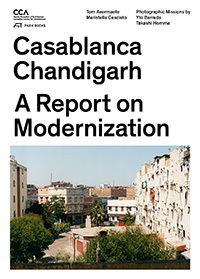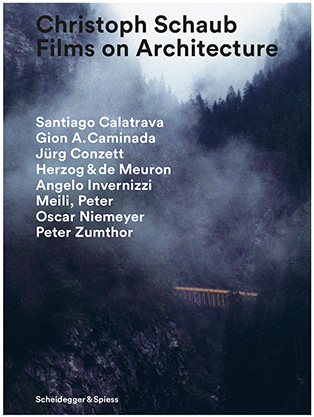
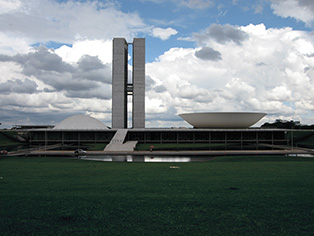
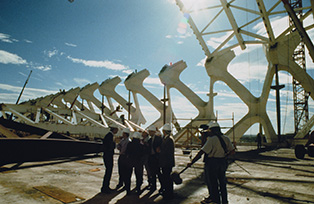
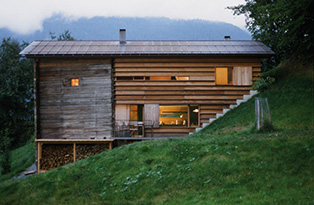
«Christoph Schaub – Films on Architecture»
Von Ingrid Isermann
Kann man Architektur filmen? Eine mögliche Antwort auf diese Frage gibt Christoph Schaub mit neun Filmen auf DVD. Der Filmemacher hat sich im dokumentarischen Teil seines OEuvres seit fast 20 Jahren zum Spezialisten entwickelt: «Man muss immer einen Umweg machen, eine Interpretation finden, um zu verstehen, was Architektur räumlich meint. Ich habe gelernt, dass man Orientierung im Raum gar nicht erzählen kann, sondern eine Fiktion herstellen muss. Auch meinen Spielfilmen ist das zugute gekommen».
Santiago Calatrava, Gion Caminada, Jürg Conzett, Herzog & de Meuron, Angelo Invernizzi, Meili, Peter, Oscar Niemeyer, Peter Zumthor:
Drei DVD’s erzählen die Architekturgeschichte dieser namhaften Architekten in den Filmen von Christoph Schaub. Dabei wird offensichtlich, wie hochsensibel sich beispielsweise das Bauen im Alpenraum zwischen Tradition und Moderne erweist, in den Ortsbildern, bei öffentlichen und privaten Gebäuden, aber auch bei rein funktionalen Bauten wie Staumauern, Brücken oder gar schlichten Stützmauern für Stasse und Bahn. Und die Frage lautet: Wie heilig soll und darf die Tradition hier sein? Schaubs Filme offenbaren, wie gründlich sich die Ingenieure – Jürg Conzett in «Die Kunst der Begründung» (2002) – oder Architekten wie Zumthor und Caminada damit auseinandersetzen und wie sie einer lebendigen Funktionalität bei wachem Geschichtsbewusstsein verpflichtet sind.
Mit Michael Schindhelm als Koautor produzierte Schaub den Film «Bird’s Nest –Herzog & de Meuron in China» (2008), als Baudokumentation des Olympiastadions in Peking, als angewandte Architekturtheorie und –praxis, und auch als Lehrstück vom interkulturellen Dialog im abenteuerlichen Business mit dem sich rasant modernisierenden China. Ein Dokument mit zeitgeschichtlichem Wert.
Der Schweizer Filmregisseur Christoph Schaub setzte sich seit seinem Erstling «Il Girasole – Una casa vicino a Verona» (1995) in weiteren Werken intensiv mit Räumen, Bauten und Landschaften und ihrer Darstellung im Film auseinander. Die DVD versammeln neun Filme zu aussergewöhnlichen Häusern und Architekten, begleitet von einem Text des Filmkritikers Martin Walder.
Die Filme über Gion A. Caminada, Peter Zumthor oder das Dorf Vrin in der Surselva thematisieren Erbauer und Gebautes im Kanton Graubünden. Eine «Utopie der Moderne» (2007) ist das Porträt der einzigartigen brasilianischen Hauptstadt. Auch mit Herzog & de Meurons spektakulärem Stadionbau in China und den Porträts über den Ingenieur Jürg Conzett und die Zürcher Architekten Marcel Meili und Markus Peter gibt Christoph Schaub einen Überblick über die profiliertesten Protagonisten der zeitgenössischen Schweizer Architektur.
Selbstverständlich ist nichts bei der Umsetzung von Architektur, von Raum in Film… Christoph Schaub, der sich in 20 Jahren zu Spezialisten entwickelt hat, weiss: «Man muss immer einen Umweg machen, um zu verstehen, was Architektur räumlich meint». Das ist Schaub meisterlich gelungen, in den Filmen wird die Architektur hautnah spürbar und die Besonderheiten der Landschaften, die auch die Architektur prägen, aufgezeigt: Bauen zwischen den Kulturen. Eine sehenswerte Reise in die Welt der Architektur.
Die Filme:
Il Girasole – una casa vicino a Verona (1995, 17 Min.).
Lieu, Funcziun e furma – L’architectura da Gion A. Caminada e Peter Zumthor (1996, 24 Min.).
Cotgla alva (1997, 24 Min.).
Il project Vrin (1999, 48 Min.)
. Die Reisen des Santiago Calatrava (1999, 77 Min.).
Die Kunst der Begründung – Jürg Conzett (2001, 14 Min.).
Der Wechsel der Bedeutungen – Meili, Peter (2001,14 Min.).
Brasilia – Eine Utopie der Moderne (2007, 26 Min.).
Bird’s Nest – Herzog & de Meuron in China (2008, 87 Min.).
Christoph Schaub
Films on Architecture
Scheidegger & Spiess, Zürch, 2014
Mit Texten von Martin Walder und Christoph Schaub
1. Auflage, 2014
3 DVDs mit Begleitbuch d/e
Filme in Originalfassung mit Untertiteln
Deutsch / Englisch / Französisch. Spieldauer total ca. 320 Min., farbig
Begleitbuch: Text Deutsch und Englisch; gebunden, 24 Seiten,
14 farbige und 2 sw Abbildungen
14 x 18.5 cm
CHF 39. € 34.
ISBN 978-3-85881-908-6
© Scheidegger & Spiess, Zürich, 2014
www.scheidegger-spiess.ch
L&K-Buchtipp
«CASABLANCA CHANDIGARH – A Report on Modernization»
A groundbreaking reassessment of the urbanist experiments Casablanca and Chandigarh.
Casablanca Chandigarh: A Report on Modernization is part of a broader project by the Canadian Centre for Architecture (CCA) encompassing the acquisition of the Pierre Jeanneret archive and the exhibition How architects, experts, politicians, international agencies, and citizens negotiate modern planning: Casablanca Chandigarh , with guest curators Tom Avermaete and Maristella Casciato.
Triggered by the acquisition of the Jeanneret archive, the CCA embarked on a research project with 2010 Mellon Senior Fellow Maristella Casciato. The Report also embodies the CCA’s long-standing interest in the possibility that apparently clashing ideas, ideologies or systems – in this case urban and architectural, originating from different times and geographies and emerging from multiple motivations – can not only coexist but, more interestingly, produce a genuine and productive third way.
This richly illustrated volume invites us to think afresh about urban life and the modern city by offering images and analyses of two very different but complementary contemporary cities: the planned Indian city of Chandigarh and Casablanca, the North African harbor town developed into a modern metropolis by Michel Ecochard and a team of architects after World War II. Countering the dominant view of modern urbanism that values avant-garde ideas originating in the West, the book offers a more nuanced approach to the history of the modern city and the relationship between local knowledge and imported ideas in the rapid globalization that followed World War II. By focusing on the design and habitation of the cities’ public spaces and housing, the Casablanca Chandigarh locates the essence of the modern city in its everyday life—which shifts our understanding of architecture and planning, enabling us to see it as the result of negotiation among a variety of actors.
Casablanca and Chandigarh are very different cities. The area which is today Casablanca was settled since antiquity by Berbers, Phoenicians, Romans and later Portuguese. From 1910 the French took control, renovating and building the ancient city destined to become Mororrco’s economic capital. Chandigarh is a completely new city, whose construction took place in the years following India’s independence from British colonial rule in 1947. The historical conditions that marked the planning of the vast new urban extensions in the case of Casablanca, and the birth of a new capital in the case of Chandigarh, form the backdrop of the investigation.
Another aspect worth noting lies in the fact that the modern buildings and neighborhoods of these cities were not the work of single author, or artistic genius, though in the case of the Punjabi capital Le Corbusier’s imprint over shaded that of any other contributor. Modern urbanism in Casablanca and Chandigarh is not a universal recipe that has been applied to these specific locations, but is rather the result of elaborate encounters, exchanges and cooperation between various transnational and local actors. The ways that these actors negotiated varying government policies, design approaches and construction methods into a complex built environment have defined the particular articulations of modern urbanism in Casablanca and Chandigarh.
AUTOREN & HERAUSGEBER
TOM AVERMAETE is professor of architecture at Delft University of Technology with a special research interest in the public realm and the architecture of the city in Western and non-Western contexts.
MARISTELLA CASCIATO, born 1950, is an architect, professor of architectural history at the Faculty of Architecture “Aldo Rossi” at Cesena, University of Bologna, and Associate Director Research at the Canadian Centre for Architecture (CCA) in Montreal. She has also carried out extensive research on the architect Pierre Jeanneret and his involvement in the planning and construction of Chandigarh.
Tom Avermaete, Maristella Casciato.
«CASABLANCA CHANDIGARH – A Report on Modernization»
Photographic Missions by Yto Barrada and Takashi Homma.
Preface by Mirko Zardini
Park Books
1st edition, 2014
Text in English only
Paperback
368 pages, 224 color and 124 b/w illustrations
17 x 24 cm
CHF 42.00 | EUR 35.00
ISBN 978-3-906027-36-4
In cooperation with Canadian Centre for Architecture (CCA), Montreal
